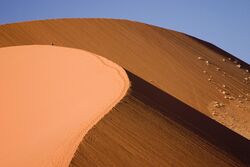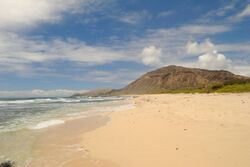Desert sand (color)
| Desert Sand | |
|---|---|
| Hex triplet | #EDC9AF |
| Source | Crayola |
| ISCC–NBS descriptor | Pale orange yellow |
Desert sand is a very light and very weakly saturated reddish yellow colour which corresponds specifically to the coloration of sand. It may also be regarded as a deep tone of beige.
Desert sand was used by General Motors, along with "rosewood", as a paint color for their early Cadillacs.
In 1998, desert sand was made into a Crayola crayon colour.[1][2]

The color shown matches the palest of the three colors in the 3-color Desert Camouflage Uniform of United States Armed Forces, which in 1990 began to replace the 6-color Desert Battle Dress Uniform.
Six Color Variations of Desert Sand
Sandy brown
| Sandy Brown | |
|---|---|
| Hex triplet | #F4A460 |
| Source | X11 |
| ISCC–NBS descriptor | Moderate orange |
As its name suggests, sandy brown is a shade of brown which is similar to the color of some sands.
Earth yellow
| Earth Yellow | |
|---|---|
| Hex triplet | #E1A95F |
| Source | Internet |
| ISCC–NBS descriptor | Moderate orange yellow |
Earth yellow is one of the twelve official camouflage colors of the United States Army.[3][4]
Sand
| Sand | |
|---|---|
| Hex triplet | #C2B280 |
| Source | ISCC-NBS |
| ISCC–NBS descriptor | Grayish yellow |

Sand is a color that resembles the color of beach sand. In fact, another name for this color is beach,[5] an alternate color name in use for this color since 1923.[6]
The first recorded use of sand as a color name in English was in 1627.[7]
The normalized color coordinates for sand are identical to ecru, which was first recorded as a color name in English in 1836.[8]
The San Diego Padres of Major League Baseball currently use Sand as one of their team colors.
Desert
| Desert | |
|---|---|
| Hex triplet | #C19A6B |
| Source | ISCC-NBS |
| ISCC–NBS descriptor | Light yellowish brown |
Desert is a color that resembles the color of the flat areas of a desert.
The first recorded use of desert as a color name in English was in 1920.[9]
The normalized color coordinates for desert are identical to fallow, wood brown and camel, which were first recorded as color names in English in 1000,[10] 1886,[11][lower-alpha 1] and 1916,[13] respectively.
Sand dune (Drab)
| Sand Dune | |
|---|---|
| Hex triplet | #967117 |
| Source | ISCC-NBS |
| ISCC–NBS descriptor | Moderate olive brown |
Sand dune is a color that resembles the color of a sand dune composed of dark colored sand.
The first recorded use of sand dune as a color name in English was in 1925.[14]
The normalized color coordinates for sand dune are identical to the color names drab, mode beige and bistre brown, which were first recorded as color names in English, respectively, in 1686,[15] 1928,[16] and 1930.[17]
Field drab
| Field Drab | |
|---|---|
| Hex triplet | #6C541E |
| Source | ISCC-NBS |
| ISCC–NBS descriptor | Moderate olive brown |
Field drab is one of the twelve official camouflage colors of the United States Army.[3][4]
Desert sand in human culture
- Earth yellow is a popular color for women’s handbags.[citation needed]
Interior design
- The tones of desert sand are called desert colors because they suggest the colors of the landscape of and of the design of the Native American cultures of the Southwestern United States. The desert colors are widely used (with both tones of sky blue or turquoise and tones of maroon to complement them) in Southwest Design.[18]
Military
- The colors desert sand, earth yellow, sand, and field drab are all on the list of the twelve standard camouflage colors used by the United States Department of the Army.[3][4]
Notes
References
Bibliography
- Maerz, Aloys John; Paul, Morris Rea (1930). A Dictionary of Color. New York: McGraw-Hill Book Company. OCLC 1150631.
- Ridgway, Robert (1886). Nomenclature of Colors for Naturalists, Compendium of Useful Knowledge for Ornithologists. Boston: Little, Brown and Company. OCLC 768502. https://archive.org/details/nomenclatureofc00ridg/mode/2up.
- Ridgway, Robert (1912). Color standards and color nomenclature. Washington, D.C.: Robert Ridgway. OCLC 630954. https://archive.org/details/colorstandardsc00ridg/mode/2up.
Citations
- ↑ Crayola crayon chronology:
- ↑ Current Crayola crayon colors:
- ↑ 3.0 3.1 3.2 Color, marking, and camouflage pattern painting for armament command equipment, United States Department of the Army, 1988
- ↑ 4.0 4.1 4.2 The 12 official MERDC camouflage colors (color samples shown):
- ↑ Maerz & Paul, p. 48
- ↑ Maerz & Paul, p. 190
- ↑ Maerz & Paul, p. 48; Color Sample of Sand: p. 49 Plate 13 Color Sample B2
- ↑ Gove, Philip B., ed (1961). "ecru". Springfield, MA: G. & C. Merriam. https://unabridged.merriam-webster.com/unabridged/ecru. "First Known Use: 1836"
- ↑ Maerz & Paul, p. 203; Color Sample of Desert: p. 47 Plate 12 Color Sample I7
- ↑ Maerz & Paul, p. 195; Color Sample of Fallow: p. 47 Plate 12 Color Sample B5
- ↑ Ridgway (1886), pp. 36, 54, 117; Color Sample of Wood Brown: Plate III fig. 19
- ↑ Ridgway (1912), p. 40; Color Sample of Wood Brown: Plate XL
- ↑ Maerz & Paul, p. 191; Color Sample of Camel: p. 49 Plate 15 Color Sample A6
- ↑ Maerz & Paul, p. 204; Color Sample of Sand Dune: p. 47 Plate 14 Color Sample B5
- ↑ Maerz & Paul, p. 194
- ↑ Maerz & Paul, p. 199
- ↑ Maerz & Paul, p. 53 Plate 15 Color Sample C9
- ↑ Google Images for "Southwest Design":
See also
- List of colors
 |


